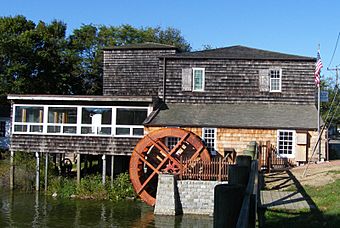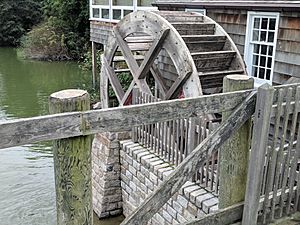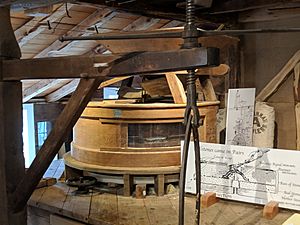Water Mill (Water Mill, New York) facts for kids
Quick facts for kids |
|
|
Water Mill
|
|

Water Mill, October 2008
|
|
| Location | Old Mill Rd., Water Mill, New York |
|---|---|
| Area | less than one acre |
| Built | 1644 |
| Architect | Howell, Edward |
| NRHP reference No. | 83004175 |
| Added to NRHP | October 13, 1983 |
The Water Mill Museum is a really old water mill that is now a museum. It's located in Water Mill, New York. This building is two stories tall and made of strong wood. It has a wooden shingle outside. The museum is made of two parts: a main square section and a smaller wing. There's also a tall tower and a glass porch at the back. This mill was built in the mid-1600s! It worked as a mill until the early 1900s. Now, it teaches people about local history.
The First Water Mill: A Look Back
The Water Mill was added to the National Register of Historic Places in 1983. This means it's an important historical site. The very first mill started grinding grains like wheat, oats, and corn way back in 1644. It was located a bit north of where the mill stands today, along Mill Creek.
English colonists from Lynn, Massachusetts, had moved to Southampton. They were part of the Puritans who settled across the Northeast. A miller named Edward Howell, who had a water mill in Lynn, chose a 100-acre pond at Mill Creek for a new mill. This spot was about three miles from Southampton.
Howell was an important town leader. He convinced the town elders to give him 39 acres of land by the pond. He also got workers and money to help build the mill. The large grinding stones for the mill were cut from two big rocks. These rocks came from a natural ridge just north of the mill site. Community mills often worked on a barter system. Farmers would give the miller about 10% of their ground grain as payment. These mills were usually built on public land.
Moving and Changing: The Mill's Journey
In 1726, people decided to move the mill south. It was moved again in 1790. The town gave permission for both moves. They also worked to make the mill run better. This included building a dam and a road at its current spot on Old Water Mill Road.
The first mill used an "overshot" water wheel. This type of wheel has water flowing over the top. But at the new dam site, an "undershot" wheel was used. This wheel has water flowing under it. Experts also found clues that a "horizontal tub water wheel" might have been used at some point.
The mill had many different owners over the years. William Ludlam Sr. bought it from Edward Howell in 1653. It stayed in the Ludlam family for more than 100 years. Later owners, like Elias Petty, William Foster, and Hugh Smith, explored new ways to use the mill. Jesse Hedges and John White used its power to weave cloth and make paper.
John Benedict arrived in 1819 to work at the mill. He was a fuller, dyer, and dresser of cloth. By 1833, he owned the mill. The Benedict family then used the building for dyeing, spinning, weaving, and fulling wool cloth. The mill still ground grain for farmers too.
When the Long Island Rail Road (LIRR) started running nearby, less water flowed to the mill. So, in 1892, the Benedicts put in a red windpump windmill to help with grinding. This windmill was later removed. By the early 1900s, the mill was no longer working.
In 1921, the Ladies Auxiliary of Water Mill (LAWM) started leasing the building. They made important repairs. They leased it every year until 1942, when they became the owners. In 1968, the LAWM began restoring the mill to become a museum. By 1976, the historic water-powered grist mill was working again. It could even show how grinding was done in the 1700s!
The Water Mill Museum holds an annual quilt show. It also has exhibits that show the history of Water Mill. Today, the Water Mill Museum Inc., a non-profit group, runs the museum.
Images for kids











